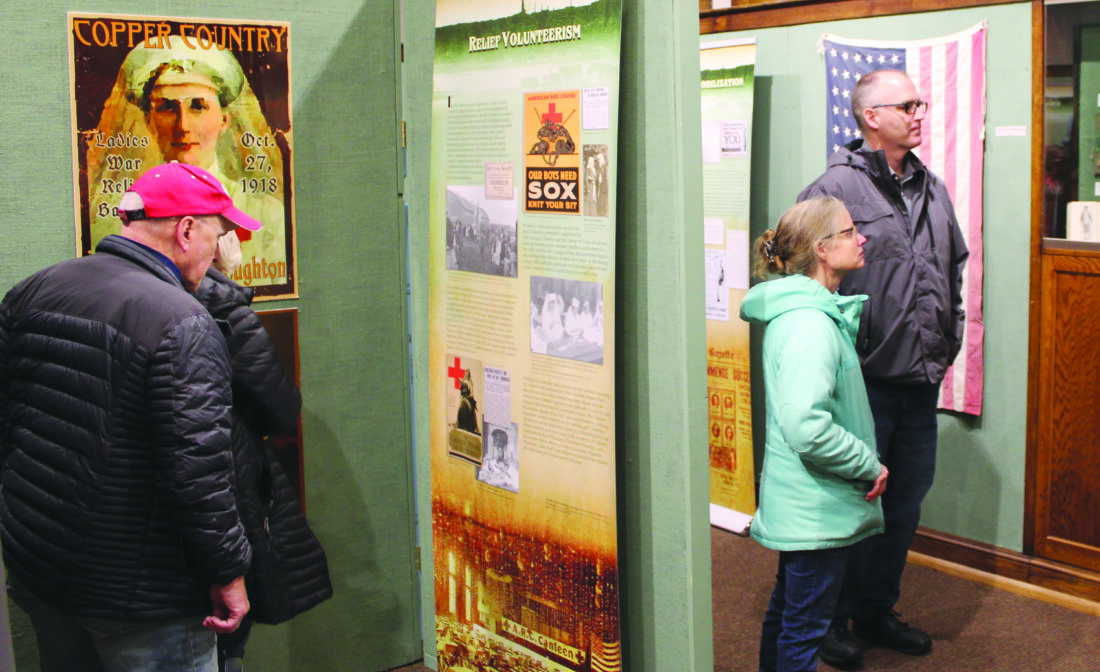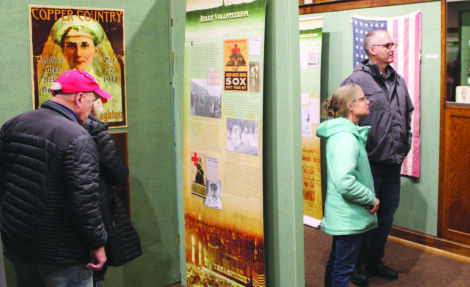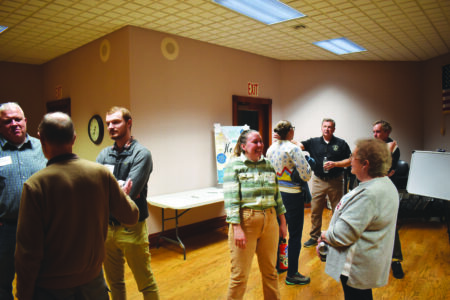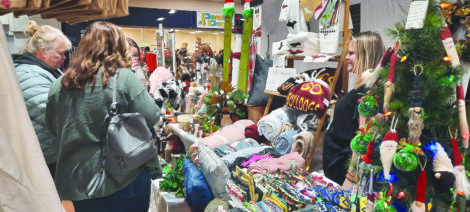Traveling back in time
Museum opens WWI exhibit

Kent Kraft/For the Gazette Visitors enjoy the new exhibit at the Cargegie Musuem Tuesday, highlighting the Copper Country's involvement in World War I.
HOUGHTON – The Carnegie Museum of the Keweenaw held a public reception for its new exhibit “World War I and the Copper Country Home Front 1917 – 1918” Tuesday. What is now Veterans’ Day, was originally Armistice Day, marking the end of World War I.
Attendees to the reception took a step back in time as they entered the museum. Food and drinks, such as Cracker Jacks and hot dogs (no longer “frankfurters”), were on offer. A pianist played pieces from the WWI era, the 1918 silent film “Shoulder Arms” staring Charlie Chaplin played on a loop, and war bond advertisements scrolled by on a digital display.
A 12-panel exhibit was the showcase for the public reception, the result of some eight years of research and work. The exhibit concept and research, originally started for the centennial observance of the United States participation in WWI during 2017 – 2018. While the exhibit was not completed at that time, many other activities, speakers, and presentations did happen. COVID-19 struck the next year, further postponing progress for the exhibit.
The delays ended up giving the committee more time to research, and they turned to the archives of the Daily Mining Gazette held by the Houghton-Keweenaw County Genealogical Society. “We wanted to give visitors a sense of what everyday people in a rural setting were seeing about World War I,” said Elise Nelson, Director of the Carnegie Museum of the Keweenaw and committee member for this exhibit. “Areas like the Copper Country were vital to the home front war efforts, and some of the articles we found in the Gazette really show that.”
One such article highlighted in the exhibit mentioned the UP of Michigan oversubscribed to the Victory Loan which was, “a most creditable showing.” The article continues, saying the performance was “better than 20 percent on the average.” Advertisements from the paper are also included, such as one for Frank Eilola & Company suggesting people try their “Lake Superior Lake Trout” and poultry for the “Meatless Day” the government was asking people to observe.
Nearly every panel in the display has images or reproductions of articles from 1916 – 1919 Daily Mining Gazette papers, showing how people in the community were doing their part. Furthermore, the exhibit shows how much advertising there was in an effort to get every citizen to go above and beyond to help in the war efforts.
“Local news, still today, is the best source to understand what a community is going through,” added Nelson. “We are thrilled we could use so much primary source material from the Daily Mining Gazette, and so happy they are still going strong today.”
Sue Collins, lead committee member for this exhibit, said she is excited the exhibit is now up for people to see. “We had a lot of setbacks with this, but we’re happy to show it off now. While we did a lot of fun events for the centennial, like actually digging out a trench for people to experience, I’m glad we got this exhibit up and running for people to see.”
For those wanting to see this exhibit first hand, the Carnegie Museum, located at the corner of Montezuma and Huron streets in Houghton, is open from noon – 5 p.m. Tuesdays and Thursdays, and noon – 4 p.m. Saturdays.
“We’re also looking forward to taking this exhibit to places outside of the museum, sharing it with more communities and schools,” added Collins. “We wrote it into the grant to get some money for this to be a traveling exhibit after it ends its run here at the museum.”
Funding for the exhibit came from a Keweenaw Heritage Grant, the Department of Humanities at Michigan Tech, and a grant from Michigan Humanities. Committee members included Collins and Nelson, as well as Steven Walton, Patricia Sotirin, and Stefka Hristova.






